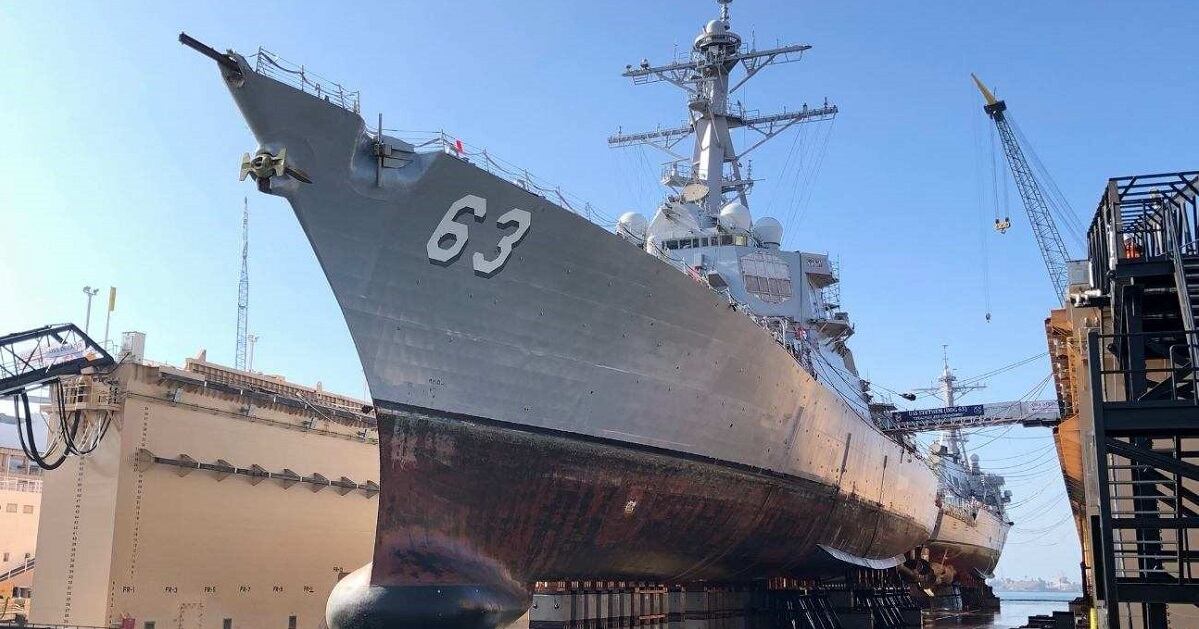We know that President Donald Trump won’t sit through a briefing on U.S. Navy force structure, so as two people who’ve spent our careers dedicated to the Navy and who worked together as the 75th secretary of the Navy and the 64th president of the Navy’s Board of Inspection and Survey — we’ll put it in terms he may understand. If you’re building a skyscraper, size matters. But you also must ensure the building is well-maintained or the whole structure crumbles.
Oh, and you do not get credit for claiming you’re building the world’s tallest skyscraper when you have no plans to do that and haven’t even tried to get funding. Yet that has been the president’s approach to the U.S. Navy. He made a campaign promise of getting the Navy to 355 ships. But, as with so much else, it’s only talk. Thanks to him, we are now on pace to build many fewer ships than we were under the Obama administration, and the maintenance backlog has gotten worse, leaving our Navy far more depleted than when he inherited it.
When it comes to the Navy, President Trump is all flash, no bang.
Let’s start with shipbuilding. Under the Obama-Biden administration, when we served, 87 ships were put under contract, more than double the number in the preceding eight years, and the fleet was growing dramatically. Trump’s promises to build more ships were, in a word, hollow. They were not backed by the budget requests to make them real. As Defense News' David Larter put it, “The president’s fiscal 2021 budget request, with its broad cuts to the destroyer program and its early ship retirements, puts the Navy on track for a 305-ship fleet by 2025, according to budget documents. That is 12 ships fewer than the 317 ships projected to be in the fleet in 2025 in Obama’s 30-year shipbuilding plan, introduced in 2016.”
One need only look through the 2021 budget request to see the administration loves grand pronouncements but never really had a plan to get to a 355-ship Navy. The five combatant vessels requested was the lowest since fiscal 2009. The administration did not even bother to submit a 30-year shipbuilding plan, the first time that has happened since FY06, and violating the law in the process. Secretary of Defense Mark Esper’s recent announcement of more funding for shipbuilding is just more of the same: a pronouncement without a plan. The secretary merely called for the defense committees to “put unused end-of-year Navy funding directly into the shipbuilding account, rather than see it expire.” That hardly qualifies as a long-term plan even if he could get approval — which, in an election year, he won’t.
The picture for ship maintenance and repairs is somehow worse. A recent independent watchdog report shows the ball’s been dropped, leaving our fleet of aircraft carriers, surface ships and submarines sitting too long in dry dock or operating too long without repairs — and making those repairs all that much more expensive and difficult when we do get around to them.
The Trump administration’s response is to kick the can down the road. Although aircraft carrier repairs were a challenge before Trump took office, delays have exploded in the rest of the surface fleet and on submarines. As the Government Accountability Office had previously made clear, these problems were at their worst in 2018: Only 15 percent of ships finished their scheduled maintenance on time.
This has real world implications. The Navy had 19 fewer surface ships available in 2019 because of maintenance delays. That means that, at a time when the United States is facing naval challenges in the Persian Gulf, the South China Sea and elsewhere, we had 19 fewer assault ships, destroyers and mine sweepers ready for use. Fewer ships also means more wear and tear on those afloat right now, delaying necessary maintenance and adding costs and time down the line. These delays worsened in 2019.
Naval shipbuilding and maintenance are not headline-grabbing topics, and probably most Americans aren’t watching. But the Chinese are. While President Trump wants to talk tough about standing up to China, he should know that the Chinese are no more afraid of his words than they are of ships that are promised but never built or ships unable to fight because they can’t leave the pier.
Like skyscrapers, shipbuilding and maintenance plans built on only words but lacking a foundation soon crumble. America’s Navy — and its citizens — deserve a Commander-in-Chief who will focus on that foundation.
Ray Mabus served as secretary of Navy during the Obama administration, from 2009 to 2017. Retired Rear Adm. Michael Smith served as commander of the John C. Stennis Aircraft Carrier Strike Group, among his many assignments during his Navy career.
The opinions expressed are those of the authors and do not necessarily reflect the views of Military Times or its staff.





